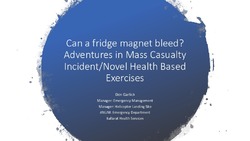Please use this identifier to cite or link to this item:
http://hdl.handle.net/11054/1231Full metadata record
| DC Field | Value | Language |
|---|---|---|
| dc.contributor | Garlick, Don | en_US |
| dc.date.accessioned | 2018-10-26T02:46:04Z | - |
| dc.date.available | 2018-10-26T02:46:04Z | - |
| dc.date.issued | 2018 | - |
| dc.identifier.govdoc | 01203 | en_US |
| dc.identifier.uri | http://hdl.handle.net/11054/1231 | - |
| dc.description.abstract | A Very Bad Thing (VBT) has happened. Staff in the Emergency Department (and elsewhere in the hospital) are expected to respond and manage the VBT as they were trained and as detailed in their plans. Except these days it is difficult to find the time to train staff and anyway the plans can be disconnected from the reality of the ED environment. A fundamental tenet of all emergency management arrangements is the requirement to exercise plans, procedures and/or personnel to ensure that organisations and individuals are capable of responding to significant incidents. Over the past 12 years Don Garlick has been responsible for developing and delivering exercises to test the response of staff and processes at a large regional hospital in Victoria. This presentation will explore the successes, pitfalls and failures of actual emergency management exercises, providing delegates with practical insights into: • Developing ‘normal business’ fire training to incorporate low frequency-high consequence emergencies • Delivering five hospital based large Mass Casualty Incident exercises • Using performance indicators to monitor performance across time and fuel improvements • The rewards of collaborating with emergency services and emergency management agencies at a local and regional level • Finding opportunities to provide hospital staff with unique health based exercises such as decontamination and VMAT deployment | en_US |
| dc.description.provenance | Submitted by Gemma Siemensma (gemmas@bhs.org.au) on 2018-10-26T02:45:27Z No. of bitstreams: 1 Don ICEN presentation.pdf: 3974668 bytes, checksum: 94948c1957b61da1fe8ec9516299c3e6 (MD5) | en |
| dc.description.provenance | Approved for entry into archive by Gemma Siemensma (gemmas@bhs.org.au) on 2018-10-26T02:46:04Z (GMT) No. of bitstreams: 1 Don ICEN presentation.pdf: 3974668 bytes, checksum: 94948c1957b61da1fe8ec9516299c3e6 (MD5) | en |
| dc.description.provenance | Made available in DSpace on 2018-10-26T02:46:04Z (GMT). No. of bitstreams: 1 Don ICEN presentation.pdf: 3974668 bytes, checksum: 94948c1957b61da1fe8ec9516299c3e6 (MD5) Previous issue date: 2018 | en |
| dc.title | Can a fridge magnet bleed? – adventures in mass casualty incident/novel health based exercises. | en_US |
| dc.type | Conference | en_US |
| dc.type.specified | Presentation | en_US |
| dc.bibliographicCitation.conferencedate | October 10-12th | en_US |
| dc.bibliographicCitation.conferencename | 16th International Conference for Emergency Nurses (ICEN) | en_US |
| dc.bibliographicCitation.conferenceplace | Melbourne | en_US |
| dc.subject.healththesaurus | EMERGENCY DEPARTMENT | en_US |
| dc.subject.healththesaurus | DISASTER RESPONSE | en_US |
| dc.subject.healththesaurus | TRAINING EXERCISES | en_US |
| dc.subject.healththesaurus | EMERGENCY MANAGEMENT | en_US |
| dc.subject.healththesaurus | MASS CASUALTY | en_US |
| dc.subject.healththesaurus | REGIONAL HOSPITAL | en_US |
| Appears in Collections: | Research Output | |
Files in This Item:
| File | Description | Size | Format | |
|---|---|---|---|---|
| Don ICEN presentation.pdf | 3.88 MB | Adobe PDF |  View/Open |
Items in DSpace are protected by copyright, with all rights reserved, unless otherwise indicated.
